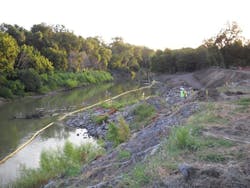About the author: Jason Fernberg is area manager, Texas office, for Maccaferri. Fernberg can be reached at [email protected] or 972.436.2974.
The state of Texas lacks a large supply of natural water resources; it is thus forced to stockpile water in reservoirs throughout the state, which often are long distances from water treatment plants. The city of Dallas has a 72-in. water transmission supply line that brings millions of gallons of water to treatment facilities, servicing the city and surrounding communities.
Sections of the supply line in Dallas run parallel to the Trinity River, which has been well known for flooding since the early 1900s; in 1990, the river experienced record floodwaters. Over the years, flash floods and changes in river depths have caused significant bank erosion. If left alone, the bank erosion potentially could expose partial sections of the supply line, leading to the possible risk of river debris colliding with and damaging the supply line in a matter of years. To avoid this situation, the city of Dallas began looking for solutions to protect the banks from eroding and to prevent damage to the supply line.
Fixer-Upper
It was determined that an erosion control solution was needed to protect various sections within a 6,500-ft stretch of river bank. In addition, the soil surrounding the supply line needed to be secured. To stabilize the soil surrounding the supply line, a turbidity curtain was placed in the river for soil retention prior to construction. The solution chosen to protect the river bank was a gabion wall reinforced with soil nail anchors. Gabion mattresses with gabion toe protection also were included in the solution to prevent slope failure and scour in front of the wall.
Maccaferri gabions and gabion mattresses were selected for strength, flexibility and durability, allowing for a more permanent solution to the city’s erosion control needs. The gabions are baskets manufactured from 8-by-10 double-twisted hexagonal woven steel wire mesh, as per ASTM A975 standards. (“8 by 10” refers to millimeters, and is not the size or length of the baskets or mattresses. The sizes can vary, but this refers to the mesh opening of the hexagonal shape.) They are filled with stones at the project site to form flexible, permeable monolithic structures—in this case, a retaining wall. The gabions are manufactured and then shipped, with all components mechanically connected at the site of installation.
Similar to gabions, Maccaferri gabion mattresses also are made of 8-by-10 double-twisted hexagonal woven steel wire mesh and are supplied with a lid as a separate panel. Gabion mattresses are divided into cells by means of diaphragms to restrict the movement of stone and strengthen the structure. Soil nail anchors, which measured 82 to 106 ft in depth, were used to tie back the gabion wall. Concrete pillars, placed 46.5 ft straight down into the earth, also were used as deep toe anchors. The gabions and gabion mattresses were assembled and put into place before being filled with stone.
The city of Dallas selected Greg Sherman of DCI Contracting Inc. to complete the project installation. Sherman, his foreman and crews utilized a 450 Hitachi excavator with a 60-ft Long Stick to place the stone into the gabion baskets and mattresses. Other installation equipment used included a 200 Kobelco crawler excavator, T300 Bobcat track loader and a 930 Caterpillar loader.
A Model 24 HD Rev Drill was used to install the anchors, which were mounted to a 300 Komatsu. This particular drill was chosen because it allowed the crew to drill 12 ft over or under the work platform, which utilized a casing for the protection and quality of the anchor installation. The eight-person construction crew at DCI Contracting averaged an installation rate of 48 cu yd per day.
Jobsite Challenges
The continuous fluctuation of the Trinity River was a constant challenge for the installation crew. Minimal rainfall—as little as 1 in.—in a radius of 40 miles away from the jobsite caused the river to fluctuate and rise up to 6 ft in height. Two inches of rainfall caused the river to rise up to 12 ft in height. There were multiple times during the installation when the river crested at 35 ft above the working area, making installation difficult. Dealing with the rising and receding river was extremely challenging while the excavation work was being completed. Upon completion of the gabion wall, 15,000 cu yd had to be dredged by design.
According to Sherman, the benefit to building a gabion wall, from a contractor’s point of view, was that the wall could be built and secured at any point along the height and length every day prior to leaving the jobsite. This allowed for better quality control, workmanship and integrity of the existing riverbank where the 72-in. reinforced concrete cylinder pipe was located. Phase I of this project was completed in October 2012, and it has proven to be an effective solution in controlling the bank erosion and protecting the water supply line.
Download: Here


